A History of San Diego Government
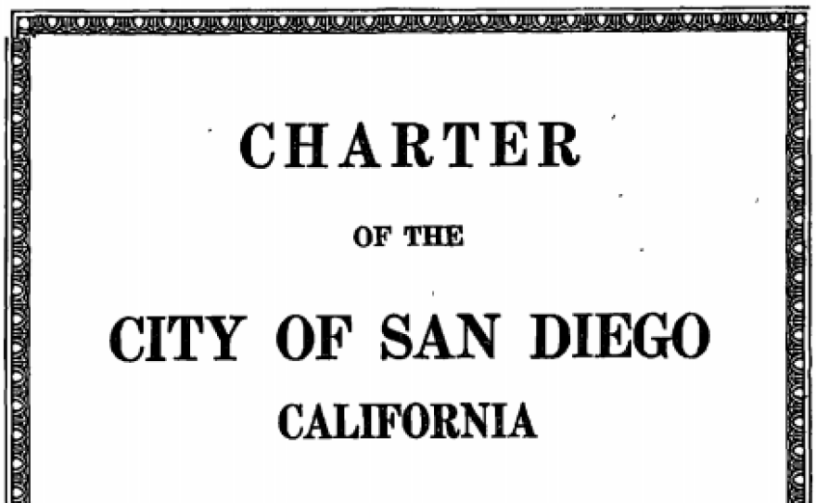 | 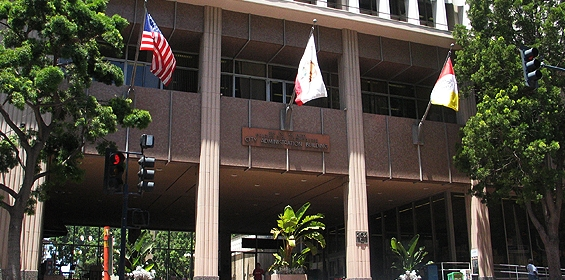 | 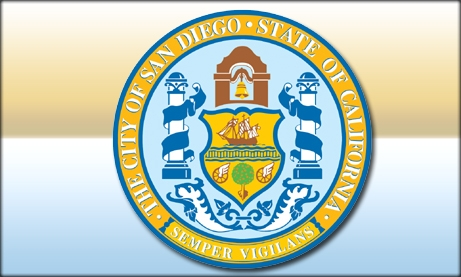 |
| 1931 City Charter | Strong Mayor (Permanent) | Evolution of City Government |
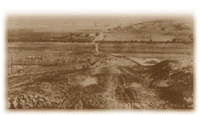
March 27, 1850:
San Diego establishes itself as the bench of San Diego County and conceded as a City Charter by the legislature of California. San Diego was incorporated as a city government consisting of a Common Council, Mayor, City Marshall, City Attorney, City Clerk, City Assessor, and City Treasurer, all elected to their positions.
1852:
The City went bankrupt and the state dissolved the government, replacing Council with the Board of Trustees in which consisted of three-members. The state held power to review and approve or disapprove actions of the Trustees.
1872:
A new County Government Act provided for the reincorporation of the City and increased the number of Trustees to five.
1876:
A new City Charter was adopted. The administration of City affairs was continued by a board of five Trustees.
1888:
A board of 15 Freeholders was elected by Special Election to prepare and propose a charter for the City of San Diego. The City Charter was adopted by the voters of San Diego on March 2, 1889, and approved by the legislature on March 16, 1889. It went into effect on May 6, 1889.
1889 - 1930:
Board of Alderman (9 members):1890 - 1905
Board of Delegates:1890 - 1905
Common Council (9 members): 1905
The two boards had eventually dissolved by 1919, thus the Common Council was now comprised of Councilmembers.
The City Charter was adopted. The Mayor was a strong, citywide-elected executive who could veto legislation passed by the Common Council. The Common Council consisted of two Houses: a Board of Aldermen (nine members elected at large) and a Board of Delegates (two representatives from each of nine wards). The five Aldermen receiving the highest number of votes would hold office for four years; the other four would hold office for two years. The Delegates would each hold office for two years.
1905:
Revision to the City Charter: the two Houses of the Common Council were consolidated into one House of nine-members.
1909:
The Charter was amended again. The nine-member Common Council was replaced by a five-member Commission. Each Commissioner was elected at large. In addition to being a legislator, each Commissioner was responsible for the administration of a City department.
1915:
Revision: The members of the Council were no longer Commissioners. Instead, they appointed a Manager of Operations who was responsible for the administration of City departments.
1929:
A completely new City Charter was written. A committee of prominent citizens, called the Board of Freeholders, was elected. The committee prepared a charter which was turned down by the voters later that year.
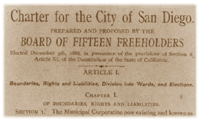
1930:
A new "Board of Freeholders" was elected. Their proposed charter was adopted by the voters.
1931 - New Charter (Manager-Council Form of Governance):
The 1931 Charter, with modifications, is still in effect today. Under the original 1931 Charter, a Manager-Council form of governance was created. A seven-member Council was created. The Council was comprised of six Councilmembers and a Mayor. The Council was nominated by district but elected citywide. The Mayor was elected citywide.
1963:
San Diego voters approved on increasing the number of council districts from six to eight.
1974:
San Diego voters approved amending City Charter section 12 to require Councilmembers, including the Mayor, to work full time.
1988:
San Diego voters approved changing the election system for Councilmembers to both nomination and election by district.
June 2, 1992:
San Diego voters approved term limits, prohibiting any person from serving more than two consecutive four-year terms as a Councilmember from any particular district or any person from serving more than two consecutive four-year terms as Mayor or City Attorney.
November 2004 - New Strong Mayor - Five Year Trial Basis:
San Diego voters approved Proposition F, which added Article XV to the City Charter, changing the City's Council-Manager form of governance to a Mayor-Council ("Strong Mayor") form of governance on a five-year trial basis. The trial period began Jan. 1, 2006 and ended Dec. 31, 2010.
This new form of governance removed the Mayor from the legislative body, and installed the Mayor as the de facto executive director of the departments and employees overseeing the City's day-to-day operations. It also introduced the concept of a Council President, chosen annually by a majority vote of the Council, to chair and set the agenda of the City Council meetings.
June 8, 2010 - New Strong Mayor Form of Governance (Permanent):
San Diego voters made permanent the New Strong Mayor Form of Governance by approving Proposition D on June 8, 2010. By passing Proposition D, voters also approved the addition of a ninth Council district, to be established by redistricting following the 2010 Census. Effective when the ninth Councilmember is seated (Dec. 3, 2012), the number of Council votes required to override a Mayoral veto on any matter will be six (two-thirds).
Throughout the transition to a Strong Mayor Form of Governance, the City Council sought to expand the number of Council Committees and redefine their role and purpose, choosing to funnel more legislative items to Council Committees to allow for increased public input and a fuller vetting process before items were sent to the full Council for consideration. By 2022 the number of Council Committees had expanded to nine.

